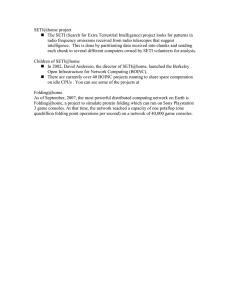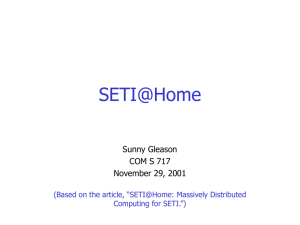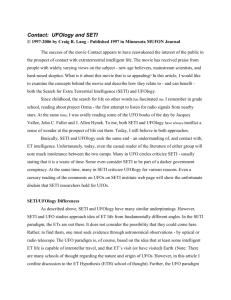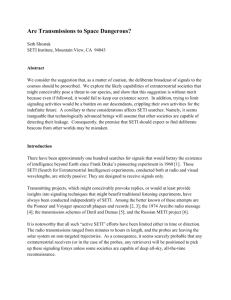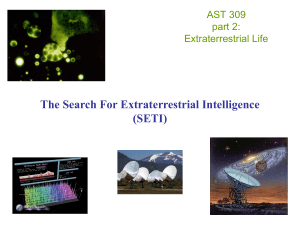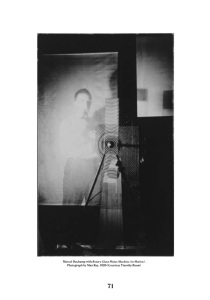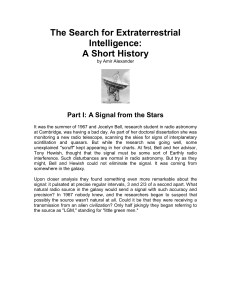Веселин Анриев Георгиев, ФН
advertisement
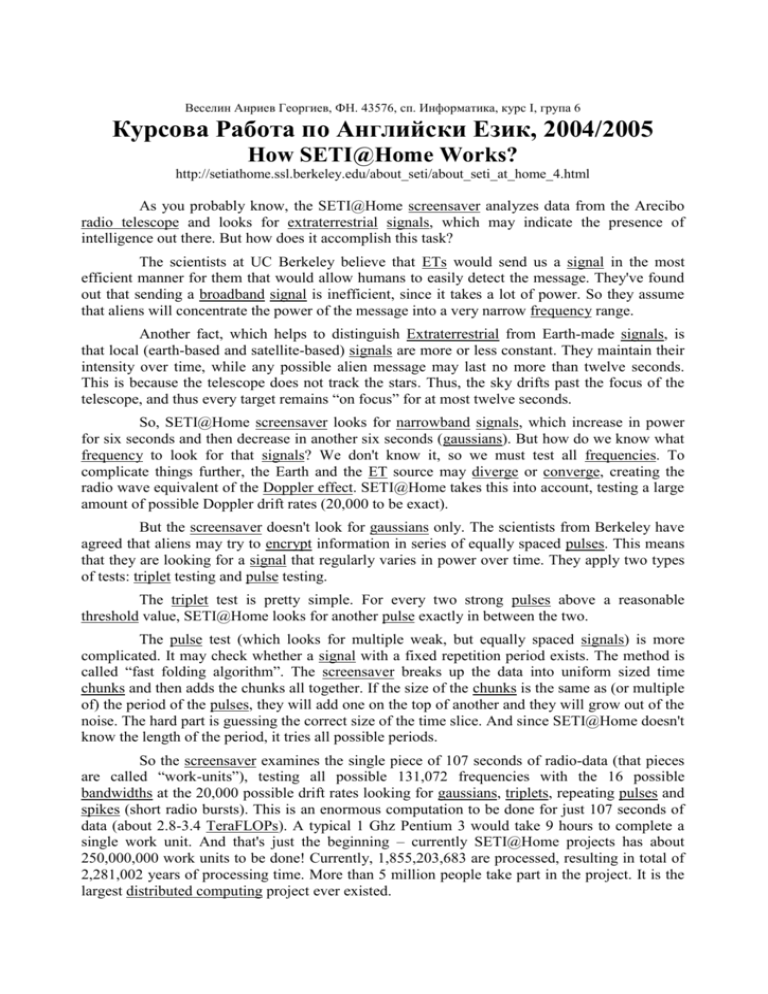
Веселин Анриев Георгиев, ФН. 43576, сп. Информатика, курс I, група 6 Курсова Работа по Английски Език, 2004/2005 How SETI@Home Works? http://setiathome.ssl.berkeley.edu/about_seti/about_seti_at_home_4.html As you probably know, the SETI@Home screensaver analyzes data from the Arecibo radio telescope and looks for extraterrestrial signals, which may indicate the presence of intelligence out there. But how does it accomplish this task? The scientists at UC Berkeley believe that ETs would send us a signal in the most efficient manner for them that would allow humans to easily detect the message. They've found out that sending a broadband signal is inefficient, since it takes a lot of power. So they assume that aliens will concentrate the power of the message into a very narrow frequency range. Another fact, which helps to distinguish Extraterrestrial from Earth-made signals, is that local (earth-based and satellite-based) signals are more or less constant. They maintain their intensity over time, while any possible alien message may last no more than twelve seconds. This is because the telescope does not track the stars. Thus, the sky drifts past the focus of the telescope, and thus every target remains “on focus” for at most twelve seconds. So, SETI@Home screensaver looks for narrowband signals, which increase in power for six seconds and then decrease in another six seconds (gaussians). But how do we know what frequency to look for that signals? We don't know it, so we must test all frequencies. To complicate things further, the Earth and the ET source may diverge or converge, creating the radio wave equivalent of the Doppler effect. SETI@Home takes this into account, testing a large amount of possible Doppler drift rates (20,000 to be exact). But the screensaver doesn't look for gaussians only. The scientists from Berkeley have agreed that aliens may try to encrypt information in series of equally spaced pulses. This means that they are looking for a signal that regularly varies in power over time. They apply two types of tests: triplet testing and pulse testing. The triplet test is pretty simple. For every two strong pulses above a reasonable threshold value, SETI@Home looks for another pulse exactly in between the two. The pulse test (which looks for multiple weak, but equally spaced signals) is more complicated. It may check whether a signal with a fixed repetition period exists. The method is called “fast folding algorithm”. The screensaver breaks up the data into uniform sized time chunks and then adds the chunks all together. If the size of the chunks is the same as (or multiple of) the period of the pulses, they will add one on the top of another and they will grow out of the noise. The hard part is guessing the correct size of the time slice. And since SETI@Home doesn't know the length of the period, it tries all possible periods. So the screensaver examines the single piece of 107 seconds of radio-data (that pieces are called “work-units”), testing all possible 131,072 frequencies with the 16 possible bandwidths at the 20,000 possible drift rates looking for gaussians, triplets, repeating pulses and spikes (short radio bursts). This is an enormous computation to be done for just 107 seconds of data (about 2.8-3.4 TeraFLOPs). A typical 1 Ghz Pentium 3 would take 9 hours to complete a single work unit. And that's just the beginning – currently SETI@Home projects has about 250,000,000 work units to be done! Currently, 1,855,203,683 are processed, resulting in total of 2,281,002 years of processing time. More than 5 million people take part in the project. It is the largest distributed computing project ever existed. Glossary: Screensaver: A software program that displays constantly changing images or dims the brightness of a display screen to protect the screen from having an image etched onto its surface. Radio Telescope: A device used in radio astronomy for detecting and recording radio waves coming from stars and other celestial objects, consisting of a radio receiver with an antenna fixed on a wide bowl-shaped reflector that collects the waves. Extraterrestrial: Originating, located, or occurring outside Earth or its atmosphere: intelligent extraterrestrial life. Signal: An impulse or a fluctuating electric quantity, such as voltage, current, or electric field strength, whose variations represent coded information. ET: short for Extraterrestrial Broadband: Of, relating to, or having a wide band of electromagnetic frequencies: a broadband network. Frequency: The number of times a specified periodic phenomenon occurs within a specified interval. Narrowband: Refers to a signal, which occupies only a small amount of space on the radio spectrum -- the opposite of broadband or wideband. Gaussian: (in SETI@Home) refers to the Gaussian (or Normal) distribution curve, usually represented by a bell-shaped curve symmetrical about the mean. Diverge: To go or extend in different directions from a common point; branch out. Converge: To tend toward or approach an intersecting point; to come together from different directions. Doppler Effect: A change in the observed frequency of a wave, as of sound or light, occurring when the source and observer are in motion relative to each other, with the frequency increasing when the source and observer approach each other and decreasing when they move apart. The motion of the source causes a real shift in frequency of the wave, while the motion of the observer produces only an apparent shift in frequency. Also called Doppler shift. Encrypt: To put into code or cipher. Pulse: A rapid, transient change in the amplitude of a signal from a baseline value to a higher or lower value, followed by a rapid return to the baseline value. Triplet: (in SETI@Home) three equally spaced strong pulses. Threshold: A transitional interval beyond which some new action or different state of affairs is likely to begin or occur. Chunk: A thick mass or piece. Bandwidth: The numerical difference between the upper and lower frequencies of a band of electromagnetic radiation, especially an assigned range of radio frequencies. Spike: Short radio burst having large amount of power. TeraFLOP: Trillion Floating Point Operations. A standard measure of a complexity of a computation task, related to the number of elementary mathematical operations on real numbers (additions, multiplications, etc.). Distributed Computing: A method of solving a large task in parallel, using many machines, each working on some little piece of the whole task.
